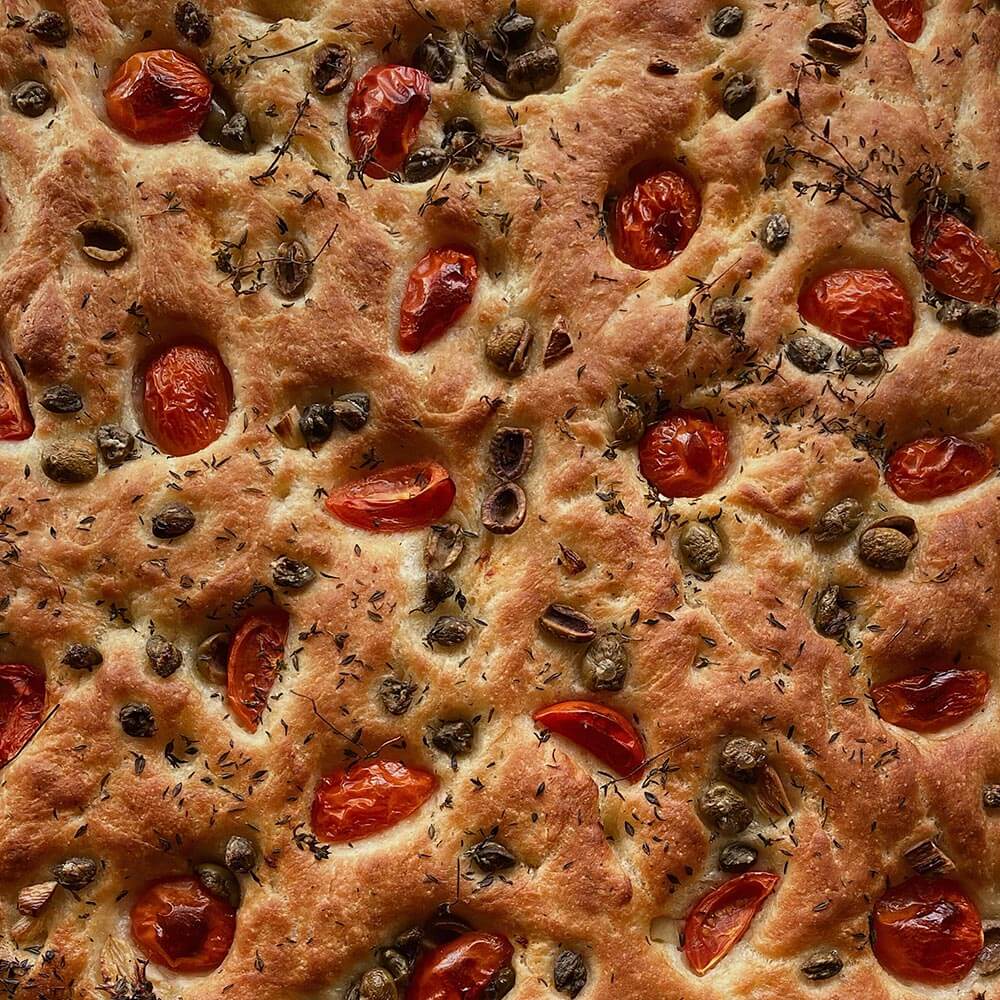This makes enough focaccia to fill one of Campbells Rofco trays which are split into 4 sections.
- 330g ripe starter
- 1650g flour (30% strong white, 60% all purpose flour, 10% wholegrain spelt)
- 1320ml water
- 33g Salt
- 33g Olive Oil
- Toppings – Basil, Garlic, Cheese, Rosemary etc.
I went through various recipes, from all the usual suspects perched on their first page of Google, like guardians of the bread Kingdom, but I found none that worked for me. So I took what I needed from each of them and mingled them together to get the result I have here.
My first problem was miscalculation. I ended up making too much starter and had to learn the dark art of bakers percentages and create my own recipe. This turned out well because the final dough was the perfect amount to fill up the large 4 section baking tray.
I’ll quickly explain how I made up the measurements using bakers percentages, which means you can do the same if you have an arbitrary amount of starter hanging around that you want to use up. But be aware that it may not fit into the trays mentioned above so snugly.
Bakers Percentages
Let’s flex our maths muscles. I had 330g ripe starter. I use 20% starter to total flour which is a 1:5 ratio, so I had to mulitply the starter by 5 to make 100% which is the total flour amount. 330 x 5 = 1650g. For bakers percentages it is customary to weigh everything against the total flour weight e.g if I want 20% starter of 1000g of flour it’s 200g which is 1000/100 x 20. Most focaccia recipes I’ve seen have a hydration level of 80% – just to reiterate that’s 80% of the total flour. So 1650/100 x 80 = 1320 which is the water in ml. Then I go with 2% salt and 2% olive oil which is 1650/100 x 3 which equals 33g. I use organic olive oil from Narajas del Carmen and various other farms on CrowdFarming.
Method
10pm Starter
I prepare my starter the night before, I mix 30g of my starter with 150g water and 150g wholmeal flour and leave it over night.
7am Focaccia Dough
In the morning at 7am I check the starter is bubbling – in the summer it goes slightly over – then mix all of the ingredients together by hand. I start by pouring the flour out onto the workstop, them making a well in the center and slowly adding the water until it’s all soaked up. Then I add the starter, mix that in quite well, then add the salt and olive oil. Keep mixing until the mixture is smooth, or if you are feeling lazy just mix it all up until it is incorporated, then pop it into a well oiled bowl – so it doesn’t sitck.
7 – 9am Stretch and Fold
Every half an hour for 2 – 4 hours depending on temperature (2 hours if it’s 20°c or longer if it’s lower than 20°c) do a stretch and fold from each side into the middle. Starting by stretching quite a lot at the beginning but being gentler and gentler as the time progresses.
9 – 9:30am Turn on the Oven
If your oven takes a long time to heat up (like a Rofco does) switch it on now and turn to 230°c. If your oven is quicker you can judge when is best to switch it on.
9am Into the Tin
Once the dough has roughly doubled in size and feels wobbly and airy – a good test to do is to shake the bowl and if the dough wobbles loosely its close to being ready. Or you can do the float test, break a bit of dough off and if it floats in water it’s ready.
Oil each compartment in the tray so when the dough goes in it’s got a good bit of oil underneath it. The tins I use are non stick so it’s less about adding oil to stop sticking and more to do with adding oil for more oil in the recipe. Divide the dough up into 4 equal pieces by weighing the dough, it should come to around 3366g. Divide this number by 4 to get 841.5g or thereabouts. This figure will of course depend on how accurate you were in the beginning weighing out your ingredients.
Push the dough in the corners of the tray and leave until doubled in size. This can take an hour or less in warm weather (20° +) or longer in cooler weather (20° or less). During the winter in the UK it can take hours if your house is particularly cold, which is why I rarely make sourdough focaccia in the winter.
10am Add Toppings
Once the dough has doubled in size glug a good load of olive oil over the top of each section and use your fingers to press it in. Then add the toppings of your choice. I press about 12 garlic cloves into each section burying it in the dough so they cook evenly and come out as soft as butter. You can try any toppings you like, treat it like a pizza. I regularly use basil, herbs, onion, cheese, flaky crystal sea salt.
11am Cooking
Once the dough has risen to at least half way up the pan, pop it in the oven for half an hour until it is golden brown. Remove form the oven, leave in the panto cool for a bit, then pull it out and leave it on a cooling rack. Eat while warm. If, like me, you make way too much for your needs you can store it in an air-tight container and reheat it in the oven.
